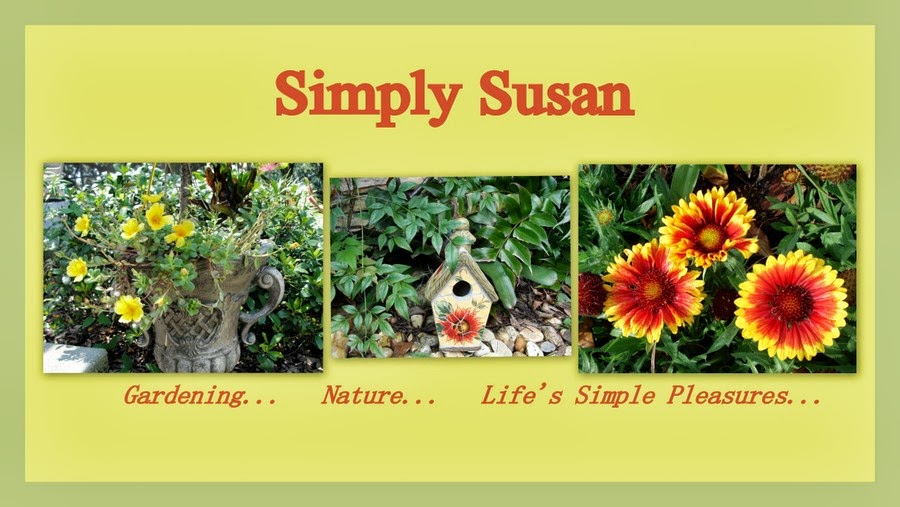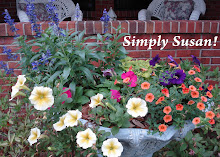Wednesday, December 24, 2014
Tuesday, December 16, 2014
At a Snail's Pace
I'm TRYING to take a lesson from the snails and move at a slower pace in my backyard. This goes against my nature because I like to get things done quickly. But with the current water restrictions, and what I believe could be a total ban on landscape watering in the not to distant future, I'm trying to create soil with good water holding abilities. This takes some time . . . so I must keep reminding myself not to rush! Slow down and be patient! It's all about the journey and not the destination!!!!
In some areas of my yard there is wonderful rich soil where years of leaf matter have decomposed into a pretty nice loam . . . at least by Florida standards. In other areas . . . Compacted soil, red clay or builder's sand . . . Not so great.
These are the areas that I have to work on the most. I've been reading about a permaculture practice where they place sticks and twigs on the soil, add compost on top, then wait for it all to breakdown before planting in the newly enriched raised bed. This is called the hugelkultur method - which is a German term which roughly means "mound culture." You then have to be REAL patient while you wait for the twigs to break down. I'm not that patient, so I dig wide and deep planting holes, line them with the broken twigs, compost and leaf matter before planting the plants. I figure that the compost enriches the soil now, and in time, the twigs and leaf matter will further enrich the soil as they break down.Click here to read more about the hugelkultur method.
I like the permaculurist's idea of retaining as much dead plant material on your property by either composting it, or breaking up the small branches and twigs and placing them top of the mulched beds. It seems to make a lot of sense to retain as much organic material as possible instead of dragging it to the curb.
I once read a book called Zero Waste House which was very interesting and eye-opening ... I highly recommend it if you're into this sort of thing, and even if you're not! I know I could never have a completely "zero waste home," - - - I won't give up my toilet tissue - - - but I wonder if it's possible to come close to a zero waste yard. Sounds like it might be a fun experiment!
In some areas of my yard there is wonderful rich soil where years of leaf matter have decomposed into a pretty nice loam . . . at least by Florida standards. In other areas . . . Compacted soil, red clay or builder's sand . . . Not so great.
These are the areas that I have to work on the most. I've been reading about a permaculture practice where they place sticks and twigs on the soil, add compost on top, then wait for it all to breakdown before planting in the newly enriched raised bed. This is called the hugelkultur method - which is a German term which roughly means "mound culture." You then have to be REAL patient while you wait for the twigs to break down. I'm not that patient, so I dig wide and deep planting holes, line them with the broken twigs, compost and leaf matter before planting the plants. I figure that the compost enriches the soil now, and in time, the twigs and leaf matter will further enrich the soil as they break down.Click here to read more about the hugelkultur method.
Photo Source: Pinterest (www.permaculture.org.au)
I like the permaculurist's idea of retaining as much dead plant material on your property by either composting it, or breaking up the small branches and twigs and placing them top of the mulched beds. It seems to make a lot of sense to retain as much organic material as possible instead of dragging it to the curb.
I once read a book called Zero Waste House which was very interesting and eye-opening ... I highly recommend it if you're into this sort of thing, and even if you're not! I know I could never have a completely "zero waste home," - - - I won't give up my toilet tissue - - - but I wonder if it's possible to come close to a zero waste yard. Sounds like it might be a fun experiment!
Afterall, gardening really is just one experiment after another. Sometimes we're successful, and sometimes we're not. The best part is we keep learning, and when we're successful we get beautiful flowers and delicious vegetables. Who knew science could be so much fun!
Thursday, December 11, 2014
In Search of Red
Because it's the holiday season, I planted a few containers with some red annuals for a bit of color in my hum-drum backyard. Lucky for me, hummers are attracted to red and it didn't take long for one to show up! A week after seeing the Mockingbird in my fountain, I was standing at the back door looking out over the backyard, as I so often do, and thinking about which plants to plant where when unexpectedly, the hummer appeared just a few feet in front of me. I let out a gasp and watched as he darted from one red flower to another.
At first he visited this container of red million bells . . .
before darting on to these red striped petunias. He then headed for a pot of red poinsettias before changing his mind, and ...
deciding to check out the spike of African blue basil flowers.
When he left the patio he darted all over the backyard in search of more red. Unfortunately, there wasn't anything else of interest, so he headed over to the neighbor's house for a visit. A few days later I moved the red pentas that were planted on the side of the house to the backyard in hopes of enticing this little fella to come more often. Now, I'm going to head to the nursery and pick up a firespike plant or two.
So happy to see the little critters showing up one by one!
Thursday, December 04, 2014
Taking a Dip
One of my goals for 'ma petit' garden space is to fill it full of plants that provide a variety of nectar, berries and seeds for butterflies and birds. I'm blessed with quite a few American beautyberry plants that were already on the property, and many of my favorites - salvias, daylilies, agapanthus, bronze fennel, parsley, roses, pentas, sparkleberries, Simpson stoppers, wax myrtles and several others are still in pots waiting to be planted.
I have lots of these little rascals racing across the top of the fence line, but I really miss the birds and butterflies.
I have lots of these little rascals racing across the top of the fence line, but I really miss the birds and butterflies.
I guess for now I must be content to see and hear the birds in my neighbors' yards which are full of trees. So you can imagine my delight when I looked up from the kitchen sink and saw a Mockingbird taking a dip in my fountain that was full of rain water. There sat the fountain, surrounded only by bare ground and weeds - no seed or berry laden plants. Repeatedly, he jumped in and out of the water, and fluttered all about.
This one simple element in the garden was enough to attract this feathered-friend, who for a few moments enjoyed a blissful dip in the fountain in my garden. It was enough to bring a smile to my face, knowing that soon I'll be watching more birds drop by for a sip and a dip, and a snack on a few berries or seeds. Needless to say, I rooted through my stash of garden items in search of a couple of feeders. So, now I have hung a bird feeder and a hummingbird nectar feeder in my backyard in hopes of attracting more birds into my cozy backyard.
It gives a gardener hope that a barren piece of land can be slowly transformed into a wildlife habitat one element at a time.
Subscribe to:
Posts (Atom)
Popular Posts
-
I bet you thought this post was going to be about some gorgeous "sun-loving" island in the Caribbean or the Mediterranean...right?...
-
Years ago I read a story about a white garden ~ ~ sometimes referred to as a moon garden or twilight garden ~ ~ and ever since then I'...
-
Our first try at growing Seminole pumpkin squash turned out to be relatively fruitful. We planted a few seeds beside my daughter's swin...
-
I'm so glad you stopped by to take a stroll through my garden. We'll start in the front yard. As we step off the front porch, there&...
-
This rose is Louis Phillippe a/k/a the Cracker Rose. It is an antique rose that performs well in a partially shaded area in my yard. It'...
-
As I was strolling through the "sunny butterfly corner " of my backyard the other day, two words came to mind - Organized Chaos!...
-
Since summer I've been, way, too busy running here and there and everywhere! I'm a homebody by nature and love it when I can stay ...
-
Not only is the garden filled with beautiful spring flowers, it's also filled with the scent of subtle and strong fragrance these days...
-
Week 2 was spent mostly in the little village of Zermatt, Switzerland where you will find fantastic views of the Matterhorn. For ...
-
I'm in the state of "Seeing Red" these days! Every window I look out of I "See Red" and it's wonderful!! ...









































%20(1).jpg)





.jpeg)

















